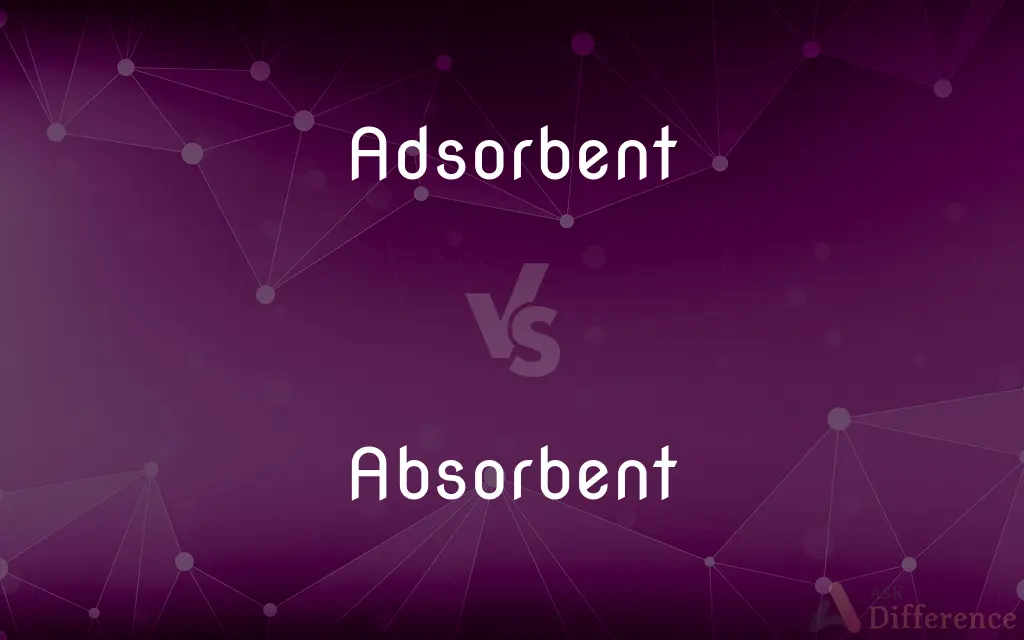Adsorbent vs. Absorbent — What's the Difference?
By Tayyaba Rehman — Updated on September 26, 2023
"Adsorbent refers to materials that hold molecules of other substances on their surface; absorbent materials soak up liquids through pores or intermolecular spaces."

Difference Between Adsorbent and Absorbent
Table of Contents
ADVERTISEMENT
Key Differences
The distinction between “adsorbent” and “absorbent” lies in the process they describe related to the interaction of substances. An adsorbent material is one that is capable of holding molecules of another substance on its surface. It involves the adhesion of atoms, ions, or molecules from a gas, liquid, or dissolved solid to a surface. In contrast, an absorbent material is one that can soak up liquids. It is characterized by the capability to incorporate liquid molecules into its structure, often through pores or intermolecular spaces, without the formation of a new compound.
Understanding the differences between adsorbent and absorbent is crucial, especially in scientific and industrial applications where the interaction between materials and substances is a fundamental consideration. An adsorbent is critical in processes such as filtration, where the material’s ability to adhere substances on its surface can help in separating or removing unwanted components from a mixture. Conversely, the application of absorbent materials is extensive in areas like hygiene products or spill control, where the material's capability to soak up liquids is of paramount importance.
The proper usage of “adsorbent” and “absorbent” is vital for conveying accurate information in scientific and technical contexts. When discussing processes involving the adhesion of molecules to a surface, “adsorbent” is the precise term to use. However, when referring to the incorporation of liquids into a material’s structure, “absorbent” is the appropriate term. The accurate employment of these terms is crucial to avoid misunderstandings and maintain clarity in scientific communication and documentation.
In practical applications, adsorbents and absorbents play significant roles in various industries. Adsorbents are extensively used in water treatment, gas purification, and in medical applications for detoxification, owing to their ability to adhere unwanted substances on their surfaces. Absorbents, with their ability to soak up liquids, find applications in everyday products like sponges, towels, and diapers, helping in managing liquids effectively. The utilization of these materials, based on their distinct properties, facilitates the development of solutions tailored to specific needs and requirements.
Comparison Chart
Mechanism
Holds molecules on its surface
Soaks up liquids into its structure
ADVERTISEMENT
Process
Involves adhesion of atoms, ions, or molecules to a surface
Incorporates liquid molecules through pores or intermolecular spaces
Application
Used in filtration, gas purification, and detoxification
Used in hygiene products and spill control
Interaction with Substance
Does not form a new compound with the substance
Incorporates the substance without forming a new compound
Industry Usage
Crucial in scientific and industrial processes
Extensively used in everyday products
Compare with Definitions
Adsorbent
Does not incorporate substances into its internal structure.
The adsorbent material captured the impurities on its surface.
Absorbent
Does not adhere molecules to its surface.
The absorbent material held the liquid within its internal structure.
Adsorbent
Used in processes involving the adhesion of atoms, ions, or molecules.
The adsorbent properties of silica gel make it ideal for moisture control.
Absorbent
A material that can incorporate liquid into its structure.
Sponges are highly absorbent, making them ideal for cleaning spills.
Adsorbent
A material that adheres molecules of another substance to its surface.
Charcoal is a common adsorbent used in water purification.
Absorbent
(of a material) able to soak up liquid easily
Absorbent kitchen paper
Adsorbent
Does not form a new compound with the adhered substances.
The adsorbent retained the contaminants without any chemical change.
Absorbent
A substance that soaks up liquid easily.
Adsorbent
Capable of adsorption.
Absorbent
Capable of absorbing a liquid or gas
Absorbent cotton.
Adsorbent
An adsorptive material, such as activated charcoal.
Absorbent
A substance that is capable of absorbing.
Adsorbent
Tending to adsorb.
Absorbent
Having the ability or tendency to absorb; able to soak up liquid easily; absorptive.
Those paper towels were amazingly absorbent. That was quite a spill.
Adsorbent
The solid or liquid in the process of adsorption on which the adsorbate accumulates.
Absorbent
Anything which absorbs.
Adsorbent
A material having capacity or tendency to adsorb another substance
Absorbent
The vessels by which the processes of absorption are carried on, as the lymphatics in animals, the extremities of the roots in plants.
Adsorbent
Having capacity or tendency to adsorb or cause to accumulate on a surface
Absorbent
(medicine) Any substance which absorbs and neutralizes acid fluid in the stomach and bowels, as magnesia, chalk, etc.; also a substance, e.g., iodine, which acts on the absorbent vessels so as to reduce enlarged and indurated parts.
Adsorbent
Critical in filtration and purification processes.
The adsorbent was effective in removing the unwanted substances from the mixture.
Absorbent
(chemistry) A liquid used in the process of separating gases or volatile liquids, in oil refining.
Absorbent
Absorbing; swallowing; absorptive.
Absorbent
Anything which absorbs.
The ocean, itself a bad absorbent of heat.
Absorbent
Any substance which absorbs and neutralizes acid fluid in the stomach and bowels, as magnesia, chalk, etc.; also a substance e. g., iodine) which acts on the absorbent vessels so as to reduce enlarged and indurated parts.
Absorbent
The vessels by which the processes of absorption are carried on, as the lymphatics in animals, the extremities of the roots in plants.
Absorbent
A material having capacity or tendency to absorb another substance
Absorbent
Having power or capacity or tendency to absorb or soak up (liquids);
As absorbent as a sponge
Absorbent
Used to soak up liquids through pores or intermolecular spaces.
The absorbent pad quickly soaked up the spilled water.
Absorbent
Extensively used in hygiene and spill control products.
Absorbent diapers are essential for infant care.
Absorbent
Can hold liquids without forming a new compound.
The absorbent towel held the water without any chemical alteration.
Common Curiosities
What does “absorbent” refer to?
Absorbent refers to materials that can soak up liquids into their structure.
Are adsorbent materials used in filtration processes?
Yes, adsorbent materials are commonly used in filtration processes due to their ability to adhere unwanted substances on their surfaces.
What does the term “adsorbent” imply?
Adsorbent implies a material that holds molecules of another substance on its surface.
Is absorbent material used for spill control?
Yes, absorbent materials are extensively used for spill control as they can incorporate and hold liquids.
Share Your Discovery

Previous Comparison
Business vs. Establishment
Next Comparison
Crunchy vs. CrispyAuthor Spotlight
Written by
Tayyaba RehmanTayyaba Rehman is a distinguished writer, currently serving as a primary contributor to askdifference.com. As a researcher in semantics and etymology, Tayyaba's passion for the complexity of languages and their distinctions has found a perfect home on the platform. Tayyaba delves into the intricacies of language, distinguishing between commonly confused words and phrases, thereby providing clarity for readers worldwide.
















































